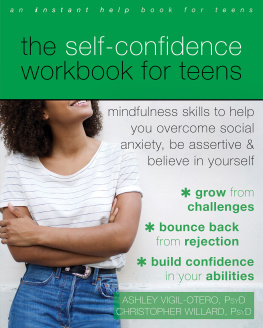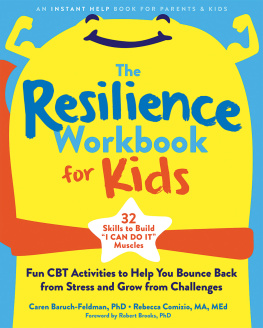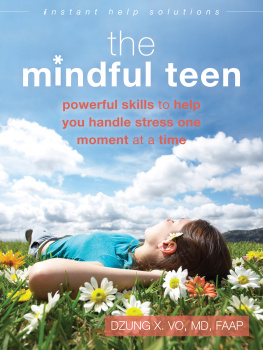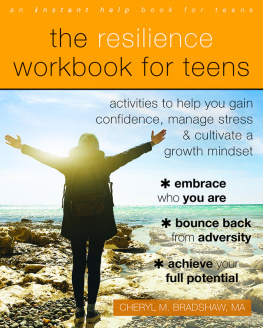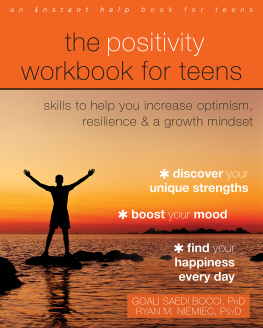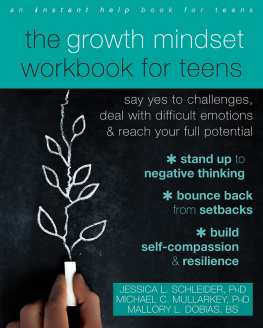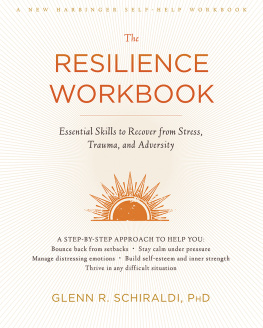

Resilience is the final frontier in human psychology. Schiraldi has created a wonderful resource and valuable compendium of academic science and practical behavioral suggestionsa powerful foundation for the acquisition of resilience skills.
George S. Everly Jr., PhD, Johns Hopkins University School of Medicine; executive director of Resiliency Science Institutes, International; and coauthor of The Secrets of Resilient Leadership
With extensive experience in mental health, academic, international crisis, and military environments, Glenn Schiraldi is uniquely prepared to offer excellent and expert guidance in developing and maintaining resilienceclarifying the best principles and practices for optimizing our physical, mental, emotional, and spiritual health and fitness under challenging circumstances. As in his previous books, Schiraldi again offers wise, caring, comprehensive, and accessible guidance. We can rely on him with trust and confidence for negotiating lifes challenges.
Edward Tick, PhD, author of War and the Soul, director of Soldiers Heart (for successful warriors return), and clinical psychotherapist focusing on veterans issues
This book is written for any person at any level of emotional health. The true beauty is that individualsbe they professionals looking to enhance their skills or people struggling with their own tragediescan implement the strategies in their own life, and then use them to strengthen and help others. This guide will be a boon to every parent and homemaker. Nearly every chapter has something Ill use on a daily basis. As a mother and a counselor, I deeply appreciate Schiraldis expertise and insight. An amazing book.
Janet Harkness, homemaker, mother, and peer counselor
The Resilience Workbook is clearly the authoritative work in the field. Schiraldi methodically takes the reader through the three critical steps of resilience training: gaining a basic understanding of the critical issues of resilience, helping the reader determine his or her own level of resilience, then guiding the reader through step-by-step exercises to build and maintain a resilient mind. Clearly a seminal work in the field of resilience.
Steve O. Steff, PhD, president and CEO of Crisis Care International
This is a great book! Comprehensive, authoritative, understandable, and practical. Schiraldi has pulled together the current research for mind and body, and produced a how-to guide to inoculate you and those you care about against the inevitable trials of life. Even better, it is a guide to healthy, happy, fulfilling living in general. Im getting a copy for every member of my family.
Thomas W. Garrett, retired major general of the US Army
Lifes trials are inevitable. How we respond to them is a product of the resilience we consciously develop, and Schiraldi shows us how.
Greg Baer, MD, author of Real Love and Post-Childhood Stress Disorder
A remarkably comprehensive, yet accessible and practical, treatise on resilience. I really believe that everyone will benefit from reading and using it. While this book will certainly benefit high-risk groups, it is also a great how-to and must-read for business professionals, entrepreneurs, students, parents, and anyone else who experiences stress and adversity.
Alan D. Boss, PhD, assistant professor of business at the University of Washington Bothell
Schiraldi goes beyond preparing or finding a way back. This resilience guide leads us to higher ground. It is the very best I have seen for both pre-occurrence preparedness and post-exposure recoveryproviding greatly encouraging, comprehensive growth and integration, especially in the core values of spirituality, meditation, religion, ethics, and morality.
Glenn Calkins, MDIV, LCSW, BCC, firefighter, EMT, fire chaplain, and certified supervisor of the Association for Clinical Pastoral Education
The importance of resilience in sports, the workplace, and life is far from a new concept. However, Schiraldi has provided one of the first truly comprehensive overviews of this critical human strength. Filled with practical advice, drills, skills, exercises, and real-life anecdotes, this guide offers us mental armor to fight the simple life challenges and daily frustrations that confront us all, in addition to the more serious and sobering anxiety, stress-provoking, and life-threatening challenges. The take-home message underscores the importance of building a mental and emotional structure that can weather a storm, and this book provides a well-researched and highly practical blueprint.
Spencer Wood, PhD, member of the Association for Applied Sport Psychology, and president of Icebox Athlete Mental Skills & Toughness Training
Publishers Note
This publication is designed to provide accurate and authoritative information in regard to the subject matter covered. It is sold with the understanding that the publisher is not engaged in rendering psychological, financial, legal, or other professional services. If expert assistance or counseling is needed, the services of a competent professional should be sought.
Distributed in Canada by Raincoast Books
Copyright 2017 by Glenn R. Schiraldi
New Harbinger Publications, Inc.
5674 Shattuck Avenue
Oakland, CA 94609
www.newharbinger.com
Activity: Self-Compassion in chapter 7 is adapted with permission from Kristin Neffs exercise Self-Compassion Break, http://www.self-compassion.org.
Story of boy skipping in chapter 12 is reprinted with permission from Teaching Children Joy by Linda and Richard Eyre (1980), 152154. Deseret Book Company.
The Pleasant Events Schedule and the instructions for using it, in chapter 21, are adapted with permission from Lewinsohn, P., Munoz, R. Youngren, M., and Zeiss, A. 1986. Control Your Depression. New York: Prentice Hall. 1986 by Peter M. Lewinsohn. Not to be reproduced without written permission from Dr. Lewinsohn. This modified version originally appeared in Schiraldi, G. R. (2001). The Self-Esteem Workbook, Oakland, CA: New Harbinger.
Figure 1.1, The resilient brain, is copyright 2004 Harderer & Mller Biomedical Art, LLC. Reprinted with permission.
Figure 1.2, The effects of substances on brain function, is reprinted by permission of Dr. Daniel Amen, http://www.AmenClinics.com. Copyright 2005 Daniel G. Amen.
Figures 2.1, Optimal arousal zone, and 2.2, Hyperarousal and hypoarousal, are adapted from figures from Crash Course: A Self-Healing Guide to Auto Accident Trauma and Recovery by Diane Poole Heller with Laurence S. Heller, published by North Atlantic Books, copyright 2001 by Diane Poole Heller. Reprinted by permission of North Atlantic Books. See also Porges (2011), Miller-Karas (2015), and Ogden, Minton, and Pain (2006).
Figure 3.1, Heart coherence versus heart incoherence, is adapted with permission from Transforming Anger: The HeartMath Solution for Letting Go of Rage, Frustration, and Irritation by Doc Childre and Deborah Rozman, copyright 2003 Doc Childre and Deborah Rozman, p. 21.
Figure 4.1, Emotional avoidance detour, was illustrated and conceptualized by Joseph Ciarrochi, Australian Catholic University, and David Mercer, University of Woolongong. Reprinted with permission.
Figure 10.1, The happiness pie: Where does happiness come from? is adapted from Is it Possible to Be Happier?, from The How of Happiness: A Scientific Approach to Getting the Life You Want
Next page


